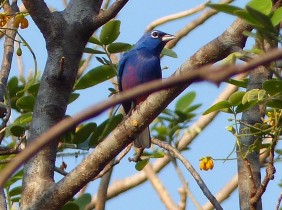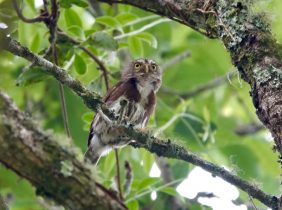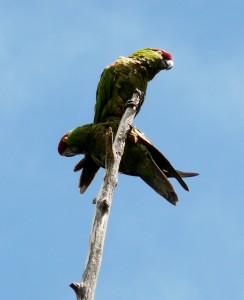
Thick-billed Parrots
Led by David MacKay and Rafael Arenas Wong
We designed our Northwest Mexico trip with the strong intention of finding three difficult West Mexican Endemic birds, all the while knowing that we would also run into a number of other really neat Mexican species along the way! The big key to this theory was to do it in the proper season, something that no other tour company is doing. Beyond the sometimes difficult climatological conditions that may exists during this season (heavy rain and sometimes extreme heat or cold), all of the bad news about Mexico up north has not helped convince people that travel in this area is safe! Unfortunately, most of the bad press appears to be greatly
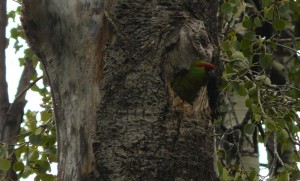
Thick-billed Parrot in Nest Cavity
exaggerated, and is effectively confusing the entire country of Mexico with a few problem areas. We had a wonderful, safe and rewarding trip, and with the exception of a rather strange interaction with two really drunk guys in Yecora, we consistently experienced warm and friendly receptions from everyone we came in contact with. It is a shame that people are reticent about traveling to Mexico right now, let’s hope the news gets better…Thick-billed Parrots need a steady stream of birders to help support the local economy with something besides logging!
Thick-billed Parrots only nest at high elevations in old growth trees and in rather remote areas of the Sierra Madre Occidental of western Mexico. Eared Quetzals look for similar habitats with the additional requirement of steep moist canyons with old growth trees. Fortunately, logging trees in steep canyons is difficult so many good nesting locations still remain in this area. Finally, Aztec Thrushes are incredibly transient, and can be very difficult to locate off of their breeding grounds. Apparently, the Madera and Yecora areas are solid and consistent nesting locals for this species. Although we dipped on Aztec Thrush in Madera we were treated to several in Yecora, including a number of juveniles begging and being fed by adults.
We made our way south from Tucson through the lushest of southeastern Arizona Sonoran deserts I have seen in a long time. Rain threatened the whole way to Bisbee, but it never came. We spent a comfortable evening at the Hotel San Ramon in the center of town. That night we had a great dinner at the Café Roka. A couple of us enjoyed the Lamb Albondigas (Mexican style meatballs) and the Asparagus Lasagna and the white corn fritters were excellent. A great way to start the trip!
The drive to the border the next morning was quick and easy, the countryside seemed to get even greener as we got closer to Agua Prieta, a product of the best monsoon in a couple of years. The paper work was minimal for the 7 day visa, and currently they are not charging for stays in the country of one week or less, this has been the case since the spring, but this policy has changed a couple of times over the past 3 years.
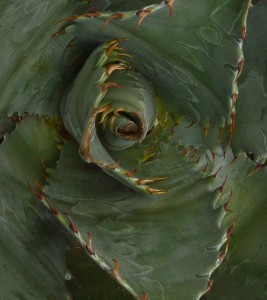
We climbed up towards the continental divide and into heavy pinyon-juniper forest, the last gasp of Sonoran desert before dropping off the east side and into the Chihuahua desert. We skirted the border with the US, only meters to the north. Our first birding stop was in juniper habitat, and I was hoping to get a look at Juniper Titmouse in the only location where it is known to exist in Mexico. No luck, but we did see our first of dozens of Blue Grosbeaks, Rufous-crowned Sparrow, Anna’s Hummingbird, and lots of Bridled Titmice.
Once crossing the pass we were now cruising through the vast expanse of Chihuahuan Desert and through the bustling city of Nuevo Casa Grandes. We set up a picnic at the Laguna Fierro on the east edge of town and saw a few birds before the rain came - Great Blue heron and Great Egret, Spotted and Baird’s Sandpiper and we heard our first Bell’s vireo.
After Casas Grandes, the drive is notably more rural and the scenery begins to change dramatically as you climb west off of the central Mexican plateau and into the Sierra at over 7000 feet. We had rain most of the way to Madera which was just fine, it limited the number of birding stops and kept us on our way. At one point the rain subsided long enough for us to make a stop at a good sized road side pond for looks at dozens of WiIson’s Phalaropes, Mexican and Ruddy Ducks and a very high elevation Black-crowned Night Heron.
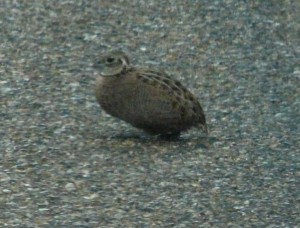
Female Montezuma Quail
Just outside of Madera we nearly ran into to a female Montezuma Quail in the middle of our lane. She was cooperative enough to give us great looks and photo ops before heading off into the woods. In total, we saw Montezuma Quail on three occasions during the tour, once with a number of juveniles.
The following morning we met with the folks from Pro Natura that would accompany us into the Thick-billed Parrot reserve. Our lead guide for the day was Javier Cruz Nieto, who runs the Pro Natura office in Madera and has been working with the Thick-billed Parrots and the Ejido Largo members who own a good portion of the remaining nesting habitat for nearly 20 years. It is a tough job for anyone, and Javier has done a great job of involving the ejido members in the conservation of the birds and their habitat. Javier brought along two local young guides who are also biology students that work with Javier on various habitat protection projects within the Parrot reserve.
We did see Parrots and lots of them. As we out of the van at our first stop, we had a flock of 11 fly high over our heads, like most parrot species you can hear them long before you see them. Eventually we came to a location where Javier had some staked out nest cavities. The first ones we came to were out to lunch but we could hear Parrots all around us and very close. Soon we found a nest cavity with a bird’s head sticking out of it and calling to a mate. We spent more than an hour watching a number of parrots and nest cavities!
The next big target was Eared Quetzal. The area around Madera is ripe with extensive areas of good habitat for the Quetzal and it is not unusual to see multiple numbers on even a short trip into the surrounding Sierra, however, today was not quite like that for us! We did eventually see a beautiful male Eared Quetzal, but only after searching extensively for a number of hours. I must admit that I was getting a bit nervous about missing the bird! Other goodies of the Sierra included a host of Arizona high country birds like Painted Redstart, Brown Creeper, Hairy Woodpecker, Mexican Chickadees, Rufous Hummingbird and Northern Flicker. We also had good looks at some not so common Arizona birds like Brown-backed Solitaire!
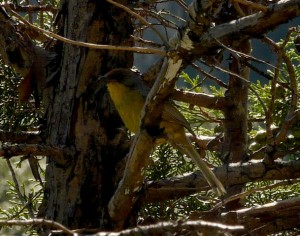
Rufous-capped Brush-finch
The afternoon took us out of the forest and over to the “Laguna Pinitas” where we lucked out on finding a pair of Common Mergansers, a great bird for the Chihuahua Sierra.
I decided to head back north again the following morning in hopes of finding Aztec Thrush at “El Salto”, a beautiful waterfall about 25 kilometers north of Madera. Unfortunately the fruiting trees were not fruiting at all! Admittedly, the birding was a bit slow, but the falls were in full flood and extremely impressive. Onward we headed north to Cuarenta Casas, a fantastic Pima Indian cliff dwelling only 4 miles north of the of the falls. We opted not to hike the 3 hour round trip to the dwellings on the other side of the canyon, and settled for the view from the parking area, which was just fine. The birding turned out to be great at the ruins as the sun began to break through the fog. We got good looks at Olive Warblers, Pygmy Nuthatch, Buff-breasted Flycatcher, an early Black-throated Gray, and Graces Warbler.
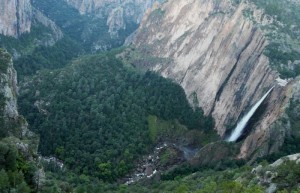
Basaceachic from the air
The afternoon was spent mostly driving to Basaseachic falls in a driving rain storm, but we did luck out in finding a dry lunch spot, complete with more Wilsons Phalaropes and a very close Zone-tailed hawk!
We arrived at the Cabanas San Lorenzo with time for a visit to the falls overlook… absolutely fantastic in the faltering light. Basaceachic is the 11
th highest single drop waterfall in the world, and with all the summer rains it certainly was impressive!
The cabins are nice and clean with good solar power for lighting. Don’t even think about charging Ipods or phones or even a coffee maker, there are no sockets in the buildings. But the tranquility and the calling Whiskered Screech owls made for a wonderfully relaxed and restful evening.
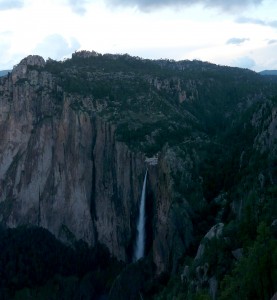
Basaceachic Falls
We spent the morning trying to find an elusive Dipper at the main entrance to the falls with eventually only getting marginal looks at a couple of fly by birds.
We hiked the main trail to the falls taking our time to look at White-striped Woodcreepers and Slate-throated Redstarts. The falls may be the best place in Mexico to get great looks at Rufous-capped Brush-finch. We saw at least 6 birds in a couple of hours, including several young birds. Once at the falls, some of the group opted for the long option with a hike back to the cabins via the overlook trail, having great looks at Rusty Sparrow along the way.
We had a nice relaxing lunch at the main lodge before taking off for Yecora, 3 hours to the west.
We got to Yecora in yet another driving rain storm and the town looked as though it had seen more than one deluge event during the summer, the streets were even more trashed than normal! The Sierra Madre Occidental has areas that routinely receive upwards of 50 inches of rain a year, and most of it comes during the summer monsoon! Unfortunately, there is not accurate data for much of the Sierra Madre and it would be interesting to see how this summer compares to past years. My guess is that it is quite a bit higher than normal.
We spent the entire morning making our way to the top of Mesa Campanero, the highest point in the state of Sonora. The entire morning was a bit slow for birds; only with heavy use of Ipod-induced Mountain Pygmy Owl was I able to extract a few birds here and there. I think it had something to do with the previous day’s storm, or maybe the impending one that would come later in the day! In any case, we dipped on the Aztec Thrush, which was now our main target bird. Fortunately, we had plenty of other things to look at...dozens of varieties of wild flowers were everywhere! Cosmos, Orchids and Begonias of various species were easy and plentiful to find!
The following morning we woke a bit earlier and we were at the traditional Aztec Thrush site
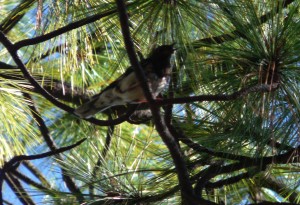
Aztec Thrush
earlier than yesterday. Persistence paid off this time and we eventually found 6 Aztec Thrushes, including at least 2 Juveniles being fed by adults, proof of breeding for sure.
Back down from the Mesa we made a stop at the near famous ‘Barranca’ and got good looks at Spotted Wrens, Rusty Sparrow, Rufous-capped Warbler, Blue Mockingbird, Slate-throated Redstart and a heard Orange-billed Nightingale Thrush.
We were burning daylight and had a long way to go to get to Hermosillo. Highway 16 drops rapidly in elevation as you head west, in no time you have left the pine-oak habitat and are surrounded by the northern limits of tropical deciduous forest. We stopped in two spots right next to the road that had interesting vegetation in steep side canyons. Here we found interesting mixes of birds; a hidden Elegant Trogon, a singing Five-striped Sparrow, Spotted Wrens feeding young, (a very low elevation for Sonora), a frenetic Rose-throated Becard, a beautiful Tropical Parula and a contented Western Wood Pewee singing away!
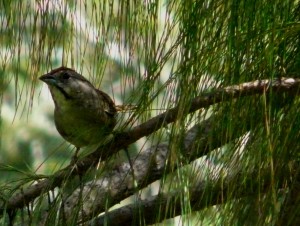
Rusty Sparrow
Then it was off to a picnic lunch along the Yaqui River. Even the shaded protection of the bridge did little to relieve the intensity of the heat; we were definitely not in the pines anymore! Bird life was pretty much restricted to river birds like Osprey, Spotted Sandpiper and Double-crested Cormorant. However I did happen to hear a Rock Wren singing in the trees, but never got a look at it.
Last stop of the day was at San Jose De Pima Bridge an hour east of Hermosillo, where we were hoping that some lower elevation birds might brave the heat of the mid-afternoon. Thanks to the water in the drainage, there were some birds, and with some work we were able to find a Yellow-billed Cuckoo, Happy Wren, Green Kingfisher, Painted and Varied Bunting and Bell’s Vireo.
The last hour into Hermosillo was spent searching the etcho cactus tops for Crested Caracaras, but even they seemed to prefer the shaded arroyos out of the intensity of the afternoon sun.
Our last day was mostly a drive back north to Tucson, but we did get a chance to make a couple of stops in Sonoran desert habitat and a couple of riparian areas. The black water ponds outside of Pesquiera held Spotted Sandpipers, Lesser Yellowlegs and Killdeer as well as a Black-throated
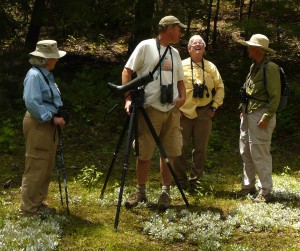
Northwest Mexico Group
Sparrow for Andree. We had our last lunch at the Elba in Santa Ana and our last birding stop in the fantastic riparian woods of the Rio Magdalena outside of the town of Imuris. Here, we picked up our only Vermillion Flycatchers of the trip
As we were blessed with great birds, good company and lots of fun, we were also treated to nothing more than a 20 minute wait at the border and a friendly border guard to end our tour!
Thank you all for a great trip!


 We climbed up towards the continental divide and into heavy pinyon-juniper forest, the last gasp of Sonoran desert before dropping off the east side and into the Chihuahua desert. We skirted the border with the US, only meters to the north. Our first birding stop was in juniper habitat, and I was hoping to get a look at Juniper Titmouse in the only location where it is known to exist in Mexico. No luck, but we did see our first of dozens of Blue Grosbeaks, Rufous-crowned Sparrow, Anna’s Hummingbird, and lots of Bridled Titmice.
Once crossing the pass we were now cruising through the vast expanse of Chihuahuan Desert and through the bustling city of Nuevo Casa Grandes. We set up a picnic at the Laguna Fierro on the east edge of town and saw a few birds before the rain came - Great Blue heron and Great Egret, Spotted and Baird’s Sandpiper and we heard our first Bell’s vireo.
After Casas Grandes, the drive is notably more rural and the scenery begins to change dramatically as you climb west off of the central Mexican plateau and into the Sierra at over 7000 feet. We had rain most of the way to Madera which was just fine, it limited the number of birding stops and kept us on our way. At one point the rain subsided long enough for us to make a stop at a good sized road side pond for looks at dozens of WiIson’s Phalaropes, Mexican and Ruddy Ducks and a very high elevation Black-crowned Night Heron.
We climbed up towards the continental divide and into heavy pinyon-juniper forest, the last gasp of Sonoran desert before dropping off the east side and into the Chihuahua desert. We skirted the border with the US, only meters to the north. Our first birding stop was in juniper habitat, and I was hoping to get a look at Juniper Titmouse in the only location where it is known to exist in Mexico. No luck, but we did see our first of dozens of Blue Grosbeaks, Rufous-crowned Sparrow, Anna’s Hummingbird, and lots of Bridled Titmice.
Once crossing the pass we were now cruising through the vast expanse of Chihuahuan Desert and through the bustling city of Nuevo Casa Grandes. We set up a picnic at the Laguna Fierro on the east edge of town and saw a few birds before the rain came - Great Blue heron and Great Egret, Spotted and Baird’s Sandpiper and we heard our first Bell’s vireo.
After Casas Grandes, the drive is notably more rural and the scenery begins to change dramatically as you climb west off of the central Mexican plateau and into the Sierra at over 7000 feet. We had rain most of the way to Madera which was just fine, it limited the number of birding stops and kept us on our way. At one point the rain subsided long enough for us to make a stop at a good sized road side pond for looks at dozens of WiIson’s Phalaropes, Mexican and Ruddy Ducks and a very high elevation Black-crowned Night Heron.







